The striatal neurotensin receptor modulates striatal and pallidal glutamate and GABA release: functional evidence for a pallidal glutamate-GABA interaction via the pallidal-subthalamic nucleus loop
- PMID: 9712666
- PMCID: PMC6792956
- DOI: 10.1523/JNEUROSCI.18-17-06977.1998
The striatal neurotensin receptor modulates striatal and pallidal glutamate and GABA release: functional evidence for a pallidal glutamate-GABA interaction via the pallidal-subthalamic nucleus loop
Abstract
In the present study, we used dual-probe microdialysis to investigate the effects of intrastriatal perfusion with neurotensin (NT) on striatal and pallidal glutamate and GABA release. The role of the pallidal GABAA receptor in the intrastriatal NT-induced increase in pallidal glutamate release was also investigated. Intrastriatal NT (100 and 300 nM) increased striatal glutamate and GABA (100 nM, 155 +/- 9 and 141 +/- 6%, respectively; 300 nM, 179 +/- 8 and 166 +/- 11%, respectively) release, as well as pallidal glutamate and GABA (100 nM, 144 +/- 8 and 130 +/- 5%; 300 nM, 169 +/- 9 and 157 +/- 8%, respectively) release. These effects were dose-dependently antagonized by the NT receptor antagonist 2-[(1-(7-chloro-4-quinolinyl)-5-(2, 6-dimethoxy-phenyl)pyrazol-3-yl)carboxylamino]tricyclo)3.3.1 .1.3. 7)-decan-2-carboxylic acid (SR48692). Intrasubthalamic injection of the GABAA receptor antagonist (-)-bicuculline (10 pmol/100 nl, 30 sec) rapidly increased pallidal glutamate release, whereas the intrastriatal NT-induced increase in pallidal glutamate release was counteracted by intrapallidal perfusion with (-)-bicuculline, suggesting that an increase in striopallidal GABA-mediated inhibition of the GABAergic pallidal-subthalamic pathway results in an increased glutamatergic drive in the subthalamic-pallidal pathway. These results demonstrate a tonic pallidal GABA-mediated inhibition of excitatory subthalamic-pallidal neurons and strengthen the evidence for a functional role of NT in the regulation of glutamate and GABA transmission in the basal ganglia. The ability of intrastriatal SR48692 to counteract the NT-induced increase in both striatal and pallidal glutamate and GABA release suggests that blockade of the striatal NT receptor may represent a possible new therapeutic strategy in the treatment of those hypokinetic disorders implicated in disorders of the indirect pathway mediating motor inhibition.
Figures
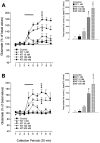
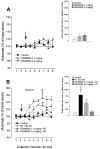
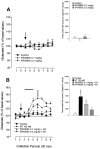

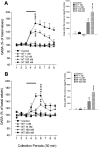
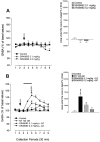
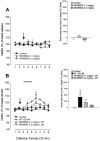
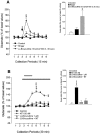


Similar articles
-
Differential effects of intrastriatal neurotensin(1-13) and neurotensin(8-13) on striatal dopamine and pallidal GABA release. A dual-probe microdialysis study in the awake rat.Eur J Neurosci. 1997 Sep;9(9):1838-46. doi: 10.1111/j.1460-9568.1997.tb00750.x. Eur J Neurosci. 1997. PMID: 9383206
-
Striatal NTS1 , dopamine D2 and NMDA receptor regulation of pallidal GABA and glutamate release--a dual-probe microdialysis study in the intranigral 6-hydroxydopamine unilaterally lesioned rat.Eur J Neurosci. 2012 Jan;35(2):207-20. doi: 10.1111/j.1460-9568.2011.07949.x. Epub 2011 Dec 30. Eur J Neurosci. 2012. PMID: 22211865
-
Functional neuroanatomy of the ventral striopallidal GABA pathway. New sites of intervention in the treatment of schizophrenia.J Neurosci Methods. 2001 Aug 15;109(1):31-9. doi: 10.1016/s0165-0270(01)00398-3. J Neurosci Methods. 2001. PMID: 11489297
-
Receptor-receptor interactions as studied with microdialysis. Focus on NTR/D2 interactions in the basal ganglia.J Neural Transm (Vienna). 2007 Jan;114(1):105-13. doi: 10.1007/s00702-006-0558-7. Epub 2006 Sep 19. J Neural Transm (Vienna). 2007. PMID: 16983483 Review.
-
Mesolimbic dopamine and cortico-accumbens glutamate afferents as major targets for the regulation of the ventral striato-pallidal GABA pathways by neurotensin peptides.Brain Res Rev. 2007 Aug;55(1):144-54. doi: 10.1016/j.brainresrev.2007.03.006. Epub 2007 Mar 24. Brain Res Rev. 2007. PMID: 17448541 Review.
Cited by
-
Elucidating the role of neurotensin in the pathophysiology and management of major mental disorders.Behav Sci (Basel). 2014 Jun 13;4(2):125-153. doi: 10.3390/bs4020125. eCollection 2014 Jun. Behav Sci (Basel). 2014. PMID: 25379273 Free PMC article. Review.
-
Neurotensin activates GABAergic interneurons in the prefrontal cortex.J Neurosci. 2005 Feb 16;25(7):1629-36. doi: 10.1523/JNEUROSCI.3579-04.2005. J Neurosci. 2005. PMID: 15716398 Free PMC article.
-
Mephedrone alters basal ganglia and limbic neurotensin systems.J Neurochem. 2014 Aug;130(3):402-7. doi: 10.1111/jnc.12727. Epub 2014 Apr 19. J Neurochem. 2014. PMID: 24678634 Free PMC article.
-
Responses of the rat basal ganglia neurotensin systems to low doses of methamphetamine.Psychopharmacology (Berl). 2014 Aug;231(15):2933-40. doi: 10.1007/s00213-014-3468-7. Epub 2014 Feb 13. Psychopharmacology (Berl). 2014. PMID: 24522333 Free PMC article.
-
Effect of methamphetamine self-administration on neurotensin systems of the basal ganglia.J Pharmacol Exp Ther. 2011 Mar;336(3):809-15. doi: 10.1124/jpet.110.176610. Epub 2010 Dec 2. J Pharmacol Exp Ther. 2011. PMID: 21131268 Free PMC article.
References
-
- Agnati LF, Fuxe K, Benfenati F, Battistini N. Neurotensin in vitro markedly reduces the affinity in subcortical limbic [3H]N-propylnorapomorphine binding sites. Acta Physiol Scand. 1983;117:299–301. - PubMed
-
- Albin RL, Young AB, Penney JB. The functional anatomy of basal ganglia disorders. Trends Neurosci. 1989;12:366–375. - PubMed
-
- Alexander GE, Crutcher M. Functional architecture of basal ganglia circuits: neuronal substrates of parallel processing. Trends Neurosci. 1990;13:266–271. - PubMed
-
- Amalric M, Farin D, Dormont JF, Schmied A. GABA-receptor activation in the globus pallidus and entopeduncolar nucleus: opposite effects on reaction time performance in the cat. Exp Brain Res. 1994;102:244–258. - PubMed
Publication types
MeSH terms
Substances
LinkOut - more resources
Full Text Sources
Research Materials
